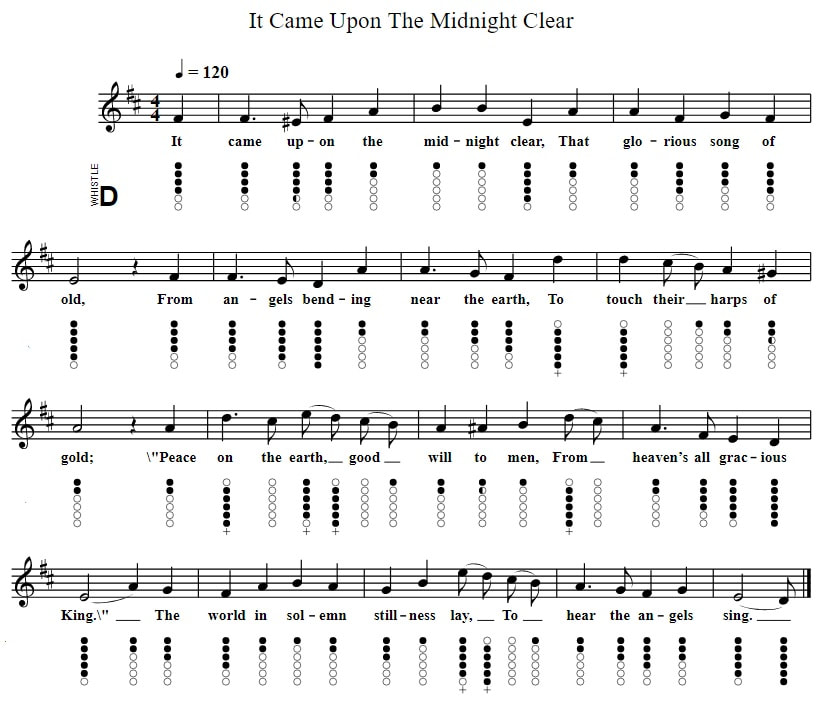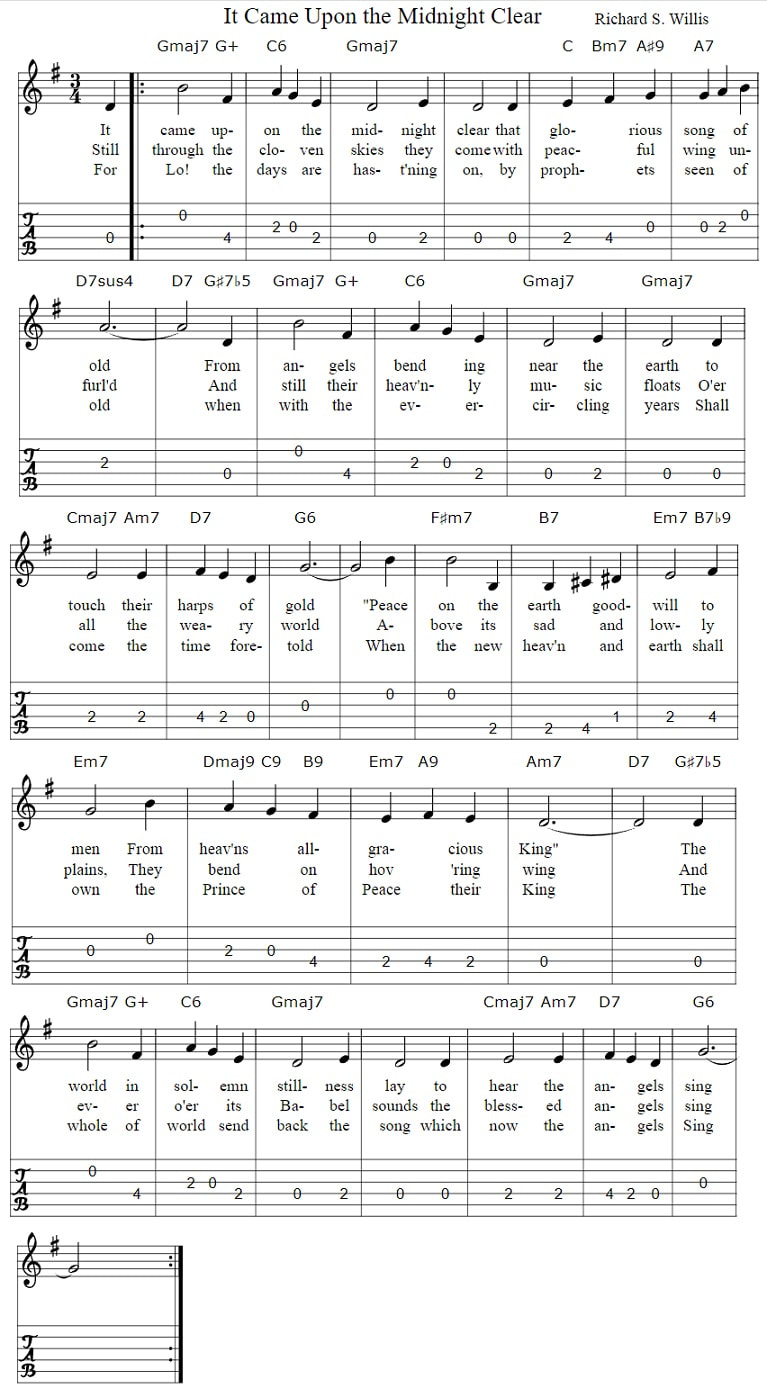It Came Upon A Midnight Clear Tin Whistle Sheet Music Plus Guitar Tab
It came upon a midnight clear tin whistle notes in D, plus the guitar tab with chords, and Banjo / Mandolin Tab. An American Christmas Carol which was written by Edmond Sears. The tune of the carol is English. Also included is another song, ''Christmas Is Coming''. Back to Christmas Tin Whistle Sheet Music .Christmas is coming piano keyboard / melodica letter notes now included for beginners. The piano chords are in the second version in D Major.
The Christmas carol, 'It Came Upon A Midnight Clear,' has been a beloved part of the holiday season for over 160 years. Written by Edmund Hamilton Sears in 1849, the carol has stood the test of time and continues to be sung and cherished by people all over the world. Its simple yet powerful lyrics and haunting melody have made it a staple in Christmas celebrations. However, the story behind the creation of this beloved carol and its enduring message of peace and hope in troubled times, make it a truly remarkable and significant piece of music.
'It Came Upon A Midnight Clear' was written during a time of great social and political turmoil in the United States. The country was still reeling from the effects of the Civil War, which had ended just four years prior. The wounds of the war were still fresh, and the nation was struggling to heal and move forward. In this environment, Edmund Hamilton Sears, a Unitarian minister from Massachusetts, wrote the poem that would later become the lyrics to the carol.
Sears was deeply troubled by the violence and unrest that he saw around him, and he longed for a message of peace and hope to be spread during the Christmas season. He drew inspiration from the biblical account of the angels appearing to the shepherds, proclaiming the birth of Jesus and bringing a message of peace on earth. In his poem, Sears expresses a similar message, calling for peace and goodwill among all people.
The lyrics of 'It Came Upon A Midnight Clear' paint a vivid picture of the scene on that quiet and holy night. The first verse sets the scene: 'It came upon the midnight clear, that glorious song of old, from angels bending near the earth, to touch their harps of gold.' The imagery of angels singing on a peaceful, starry night immediately transports the listener to the moment of Jesus' birth. The following verses continue to describe the message of peace and hope that the angels bring, and how it is still relevant and needed in the world today.
One of the most striking aspects of this carol is its focus on peace and goodwill towards all, regardless of race or social status. In the third verse, Sears writes, 'And you, beneath life's crushing load, whose forms are bending low, who toil along the climbing way with painful steps and slow, look now! for glad and golden hours come swiftly on the wing.' Here, he acknowledges the struggles and hardships of those who are marginalized and oppressed, and offers them the same message of hope and peace. This inclusive message was particularly poignant during the time when the carol was written, as the country was still grappling with issues of slavery and racial inequality.
The enduring popularity of 'It Came Upon A Midnight Clear' can also be attributed to its timeless melody. The music was composed by Richard Storrs Willis, a classical music critic and composer who was a close friend of Sears. Willis' simple yet hauntingly beautiful melody perfectly complements the lyrics and adds to the overall impact of the song.
Over the years, 'It Came Upon A Midnight Clear' has been recorded and performed by countless artists, in a variety of styles and arrangements. From traditional church choirs to modern pop versions, the carol has been interpreted in many ways, but its message remains the same. It has also been featured in numerous films, TV shows, and commercials, further cementing its place in popular culture.
In conclusion, 'It Came Upon A Midnight Clear' is more than just a Christmas carol. Its enduring popularity and widespread appeal can be attributed to its powerful message of peace and hope, and its ability to transcend time and cultural barriers. As long as there is strife and turmoil in the world, the words of this carol will continue to resonate and remind us of the true meaning of Christmas. Even after 160 years, 'It Came Upon A Midnight Clear' remains a timeless and relevant piece of music, and a testament to the enduring power of music to unite and uplift us in troubled times.
'It Came Upon A Midnight Clear' was written during a time of great social and political turmoil in the United States. The country was still reeling from the effects of the Civil War, which had ended just four years prior. The wounds of the war were still fresh, and the nation was struggling to heal and move forward. In this environment, Edmund Hamilton Sears, a Unitarian minister from Massachusetts, wrote the poem that would later become the lyrics to the carol.
Sears was deeply troubled by the violence and unrest that he saw around him, and he longed for a message of peace and hope to be spread during the Christmas season. He drew inspiration from the biblical account of the angels appearing to the shepherds, proclaiming the birth of Jesus and bringing a message of peace on earth. In his poem, Sears expresses a similar message, calling for peace and goodwill among all people.
The lyrics of 'It Came Upon A Midnight Clear' paint a vivid picture of the scene on that quiet and holy night. The first verse sets the scene: 'It came upon the midnight clear, that glorious song of old, from angels bending near the earth, to touch their harps of gold.' The imagery of angels singing on a peaceful, starry night immediately transports the listener to the moment of Jesus' birth. The following verses continue to describe the message of peace and hope that the angels bring, and how it is still relevant and needed in the world today.
One of the most striking aspects of this carol is its focus on peace and goodwill towards all, regardless of race or social status. In the third verse, Sears writes, 'And you, beneath life's crushing load, whose forms are bending low, who toil along the climbing way with painful steps and slow, look now! for glad and golden hours come swiftly on the wing.' Here, he acknowledges the struggles and hardships of those who are marginalized and oppressed, and offers them the same message of hope and peace. This inclusive message was particularly poignant during the time when the carol was written, as the country was still grappling with issues of slavery and racial inequality.
The enduring popularity of 'It Came Upon A Midnight Clear' can also be attributed to its timeless melody. The music was composed by Richard Storrs Willis, a classical music critic and composer who was a close friend of Sears. Willis' simple yet hauntingly beautiful melody perfectly complements the lyrics and adds to the overall impact of the song.
Over the years, 'It Came Upon A Midnight Clear' has been recorded and performed by countless artists, in a variety of styles and arrangements. From traditional church choirs to modern pop versions, the carol has been interpreted in many ways, but its message remains the same. It has also been featured in numerous films, TV shows, and commercials, further cementing its place in popular culture.
In conclusion, 'It Came Upon A Midnight Clear' is more than just a Christmas carol. Its enduring popularity and widespread appeal can be attributed to its powerful message of peace and hope, and its ability to transcend time and cultural barriers. As long as there is strife and turmoil in the world, the words of this carol will continue to resonate and remind us of the true meaning of Christmas. Even after 160 years, 'It Came Upon A Midnight Clear' remains a timeless and relevant piece of music, and a testament to the enduring power of music to unite and uplift us in troubled times.






